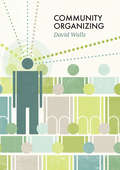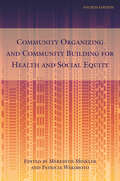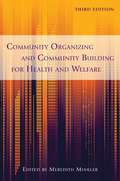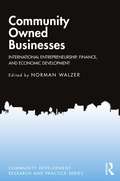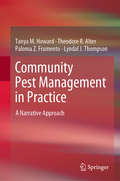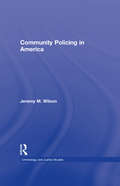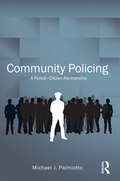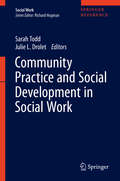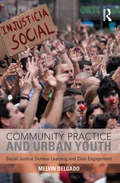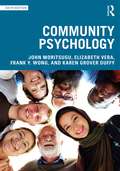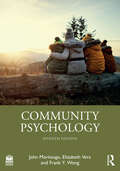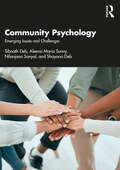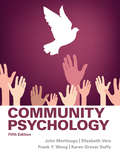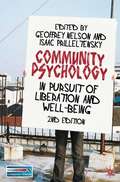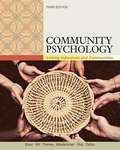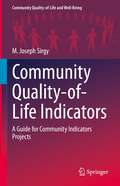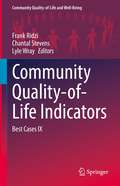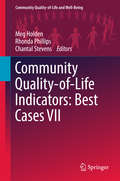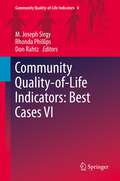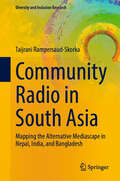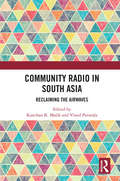- Table View
- List View
Community Organizing
by David S. WallsThis incisive book provides a critical history and analysis of community organizing, the tradition of bringing groups together to build power and forge grassroots leadership for social, economic, racial, and environmental justice. Begun by Saul Alinsky in the 1930s, there are today nearly 200 institution-based groups active in 40 U. S. states, and the movement is spreading internationally. David Walls charts how community organizing has transcended the neighborhood to seek power and influence at the metropolitan, state, and national levels, together with such allies as unions and human rights advocates. Some organizing networks have embraced these goals while others have been more cautious, and the growing profile of community organizing has even charged political debate. Importantly, Walls engages social movements literature to bring insights to our understanding of community organizing networks, their methods, allies and opponents, and to show how community organizing offers concepts and tools that are indispensable to a democratic strategy of social change. Community Organizing will be essential reading for advanced undergraduates and graduate students of sociology, social movements and social work. It will also inform organizers and grassroots leaders, as well as the elected officials and others who contend with them.
Community Organizing (Social Movements)
by David S. WallsThis incisive book provides a critical history and analysis of community organizing, the tradition of bringing groups together to build power and forge grassroots leadership for social, economic, racial, and environmental justice. Begun by Saul Alinsky in the 1930s, there are today nearly 200 institution-based groups active in 40 U.S. states, and the movement is spreading internationally. David Walls charts how community organizing has transcended the neighborhood to seek power and influence at the metropolitan, state, and national levels, together with such allies as unions and human rights advocates. Some organizing networks have embraced these goals while others have been more cautious, and the growing profile of community organizing has even charged political debate. Importantly, Walls engages social movements literature to bring insights to our understanding of community organizing networks, their methods, allies and opponents, and to show how community organizing offers concepts and tools that are indispensable to a democratic strategy of social change. Community Organizing will be essential reading for advanced undergraduates and graduate students of sociology, social movements and social work. It will also inform organizers and grassroots leaders, as well as the elected officials and others who contend with them.
Community Organizing and Community Building for Health and Social Equity, 4th edition
by Barack Obama Stephen B. Thomas Rinku Sen John P. Kretzmann Rachel Morello-Frosch Meredith Minkler Nina Wallerstein Barbara A. Israel Eugenia Eng Edith A. Parker Tom Wolff Celina Su Manuel Pastor Jason Corburn Whitney Johnson Ronald Labonté Mark S. Homan Christine Mitchell Michelle C. Kegler Patricia Wakimoto Lionel J. Beaulieu Adam B. Becker Lynn Blanchard Anne Bluethenthal Frances Dunn Butterfross Lisa Cacari Stone Caricia Catalani Charlotte Yu-Ting Chang Roxana Chen Wayland X. Coleman Chris M. Coombe Lori Dorfman Nancy Epstein Jessica Estrada Jennifer Falbe Stephanie A. Farquhar Prisila Gonzalez Joseph Griffin Leslie Grover Lorraine Gutiérrez Trevor Hancock Susana Hennesey Laverty Reva Hines Lili Farhang Solange Gould Cheryl A. Hyde Anthony B. Iton Josh Kirschenbaum Blishda Lacet Pam Tau Lee Edith A. Lewis Jennifer Lifshay Laura Linnan Shaw San Liu Shaddai Martinez Cuestas Marty Martinson John L. McKnight Mary Anne Morgan Angela Ni Susan Racine Passmore Amber Akemi Piatt Cheri A. Pies Clara Pinsky R. David Rebanal Kathleen M. Roe Zachary Rowe Alicia L. Salvatore Shannon Sanchez-Youngman Amy J. Shulz Lee Staples Makani Themba Maria Elena Torre Evan Vandommelen-Gonzalez Dierde Visser Kirsten Wysen Marisa Ruiz Asari Nickie Bazell Derek M Griffith Heather CameThe fourth edition of Community Organizing and Community Building for Health and Social Equity provides both classic and recent contributions to the field, with a special accent on how these approaches can contribute to health and social equity. The 23 chapters offer conceptual frameworks, skill- building and case studies in areas like coalition building, organizing by and with women of color, community assessment, and the power of the arts, the Internet, social media, and policy and media advocacy in such work. The use of participatory evaluation and strategies and tips on fundraising for community organizing also are presented, as are the ethical challenges that can arise in this work, and helpful tools for anticipating and addressing them. Also included are study questions for use in the classroom. Many of the book’s contributors are leaders in their academic fields, from public health and social work, to community psychology and urban and regional planning, and to social and political science. One author was the 44th president of the United States, himself a former community organizer in Chicago, who reflects on his earlier vocation and its importance. Other contributors are inspiring community leaders whose work on-the-ground and in partnership with us “outsiders” highlights both the power of collaboration, and the cultural humility and other skills required to do it well. Throughout this book, and particularly in the case studies and examples shared, the role of context is critical, and never far from view. Included here most recently are the horrific and continuing toll of the COVID-19 pandemic, and a long overdue, yet still greatly circumscribed, “national reckoning with systemic racism,” in the aftermath of the brutal police killing of yet another unarmed Black person, and then another and another, seemingly without end. In many chapters, the authors highlight different facets of the Black Lives Matter movement that took on new life across the country and the world in response to these atrocities. In other chapters, the existential threat of climate change and grave threats to democracy also are underscored.
Community Organizing and Community Building for Health and Welfare (3rd Edition)
by Meredith MinklerThe book provides new and more established ways to approach community building and organizing, from collaborating with communities on assessment and issue selection to using the power of coalition building, media advocacy, and social media to enhance the effectiveness of such work.
Community Owned Businesses: International Entrepreneurship, Finance, and Economic Development (Community Development Research and Practice Series)
by Norman WalzerThis book analyses community-owned businesses in countries around the world to show successful approaches and important strategies to improve access to essential services in vastly different economic contexts. Through eleven chapters, authors from various countries use case studies and analyse findings in ways which can be applied to new development initiatives, including rural grocery store retention in Kansas, socially responsible community cooperatives in Italy, preserving pubs and shops in England and Wales, serving residents with special needs in Canada, and financing basic goods and services for aging populations in Taiwan, plus other examples. The chapters explore practices and approaches used in various locations to address concerns about loss of access to essential services, making clear that this approach to financing is useful in different scenarios. The chapters provide key insights suggesting that these approaches will be even more prevalent in the future and will be of interest to students, scholars, and community-development practitioners around the world.
Community Pest Management in Practice: A Narrative Approach
by Tanya M. Howard Theodore R. Alter Paloma Z. Frumento Lyndal J. ThompsonThis book presents a collection of practitioner and community stories that reveal how invasive species management is a community issue that can spark community formation and collective action. It combines the unique first-person narratives of practitioners on the frontline of invasive species management in Australia with three case studies of community action for wild dog management across a range of geographical landscapes. The book offers readers a new understanding of how communities are formed in the context of managing different species, and how fundamental social and political processes can make or break landholders’ ability to manage invasive species. Using narrative analysis of practitioner profiles and community groups, drawing lessons from real-world practices, and employing theories from community development, rural sociology and collective action, this book serves multiple functions: it offers a teaching tool, a valuable research contribution, and a practitioner’s field guide to pursuing effective community development work in connection with natural resource management, wildlife management and environmental governance.
Community Policing in America (Criminology and Justice Studies)
by Jeremy M. WilsonAlthough law enforcement officials have long recognized the need to cooperate with the communities they serve, recent efforts to enhance performance and maximize resources have resulted in a more strategic approach to collaboration among police, local governments, and community members. The goal of these so-called "community policing" initiatives is to prevent neighborhood crime, reduce the fear of crime, and enhance the quality of life in communities. Despite the growing national interest in and support for community policing, the factors that influence an effective implementation have been largely unexplored. Drawing on data from nearly every major U.S. municipal police force, Community Policing in America is the first comprehensive study to examine how the organizational context and structure of police organizations impact the implementation of community policing. Jeremy Wilson’s book offers a unique theoretical framework within which to consider community policing, and identifies key internal and external factors that can facilitate or impede this process, including community characteristics, geographical region, police chief turnover, and structural complexity and control. It also provides a simple tool that practitioners, policymakers, and researchers can use to measure community policing in specific police organizations.
Community Policing: A Police-Citizen Partnership (Criminology and Justice Studies)
by Michael J. PalmiottoThis textbook discusses the role of community-oriented policing, including the police image, public expectations, ethics in law enforcement, community wellness, civilian review boards, and what the community can do to help decrease crime rates. In addition, the author covers basic interpersonal skills and how these might vary according to the race, sex, age, and socioeconomic group with which the officer is interacting. Finally, students learn how to initiate new programs in a community, from the planning process and community involvement to dealing with management and evaluating program success.
Community Practice and Social Development in Social Work (Social Work)
by Julie L. Drolet Sarah ToddThis book brings together leaders in the field of community practice and social development in social work. The chapters discuss the implications of social development in social work practice, policy, and service structures.
Community Practice and Urban Youth: Social Justice Service-Learning and Civic Engagement (Social Justice Youth Community Practice Ser.)
by Melvin DelgadoCommunity Practice and Urban Youth is for graduate level students in fields that offer youth studies and community practice courses. Practitioners in these fields, too, will find the book particularly useful in furthering the integration of social justice as a conceptual and philosophical foundation. The use of food, environmental justice, and immigrant-rights and the book’s focus on service-learning and civic engagement involving these three topics offers an innovative approach for courses.
Community Prevention of Child Labor: Evidence-based Practices to Promote the Psychological Well-being of Minors (Human Well-Being Research and Policy Making)
by Isidro Maya JariegoThis book discusses preventive actions that have led to reduction in the prevalence of child labor across the world over the 21st century. It identifies exemplary programs in the area of community prevention that have had exceptional results; for example, the involvement of children in hazardous work globally being reduced by half. It documents a wide range of contexts where concerted action has counteracted social permissiveness towards child labor, including psycho-educational interventions in preventing early school leaving and conditional cash benefits which counteract family poverty. The book presents a set of evidence-based practices that are particularly useful for psychologists, educators, and social workers. More broadly, this book is also of interest to policymakers, professionals, and activists involved in child protection policy or in implementing programs to promote the psychological well-being of children.
Community Programs To Promote Youth Development
by Committee on Community-Level Programs for YouthAfter-school programs, scout groups, community service activities, religious youth groups, and other community-based activities have long been thought to play a key role in the lives of adolescents. But what do we know about the role of such programs for today's adolescents? How can we ensure that programs are designed to successfully meet young people's developmental needs and help them become healthy, happy, and productive adults? Community Programs to Promote Youth Development explores these questions, focusing on essential elements of adolescent well-being and healthy development. It offers recommendations for policy, practice, and research to ensure that programs are well designed to meet young people's developmental needs. The book also discusses the features of programs that can contribute to a successful transition from adolescence to adulthood. It examines what we know about the current landscape of youth development programs for America's youth, as well as how these programs are meeting their diverse needs. Recognizing the importance of adolescence as a period of transition to adulthood, Community Programs to Promote Youth Development offers authoritative guidance to policy makers, practitioners, researchers, and other key stakeholders on the role of youth development programs to promote the healthy development and well-being of the nation's youth.
Community Psychology
by Karen Grover Duffy Frank Y Wong Elizabeth Vera John MoritsuguCommunity Psychology, 6th Edition offers an easy-to-navigate, clearly organized, and comprehensive overview of the field, with theoretical roots that carry over to practical applications. Presenting the concepts of community psychology and social change, these concepts are then applied to various systems addressing the human condition: mental health, medical, public health, school, legal, and industrial/organizational. Through a unique three-part approach, including concepts, interventions, and applications of the theory, the book opens the field of community psychology to students who are interested in how psychology might help themselves and the systems around them. It then focuses on the prevention of problems, the promotion of well-being, the empowerment of members within a community, the appreciation of diversity, and an ecological model for the understanding of human behavior. Attention is paid to both "classic" early writings and the most recent journal articles and reviews by today’s practitioners and researchers. Historical and alternative methods of effecting social change are explored in this book, with the overall theme that the environment is as important as the individual in it. This 6th edition will include new topical subjects such as grit and life success, changes in technology and their impact, interventions based on networking, social movements and justice, dealing with stigma, and new models of health. It will appeal to advanced undergraduates as well as graduates taking courses on community psychology, social psychology, clinical psychology, and related fields.
Community Psychology
by Elizabeth Vera John Moritsugu Frank Y. WongCommunity Psychology, 7th Edition presents the field’s conceptual roots and possible applications in a comprehensive overview of the field. Clearly organized and easy to navigate, the text is divided into sections on basic concepts, social change, applications, and the future.The book opens the field of community psychology to students who are interested in how psychology is relevant to their own lives and the systems around them. The applied chapters discuss how community psychology relates to mental health, social and health services, schools and children, law and crime, health and public health, and community/organizational psychology. The new edition updates research and literature and presents developments in theoretical and research methodologies. This edition focuses particularly on description and consideration of critical theory, liberation theology, and decolonization as part of community psychology’s intellectual and value-based evolution. Examples of community psychology in practice are provided throughout the text, and each chapter also features discussion questions for students to consider. A student website and instructor resources provide further ways to engage with the content and support teaching and learning.This highly engaging book explores social change, the mental health of the community, and the importance of the environment upon the individual. It will appeal to advanced undergraduates as well as graduates taking courses on community psychology, social psychology, clinical psychology, and related fields.
Community Psychology: Emerging Issues and Challenges
by Sibnath Deb Aleena Maria Sunny Nilanjana Sanyal Shayana DebThis book focuses on the theoretical concepts of community psychology and its applications in day-to-day life. It discusses the challenges that adversely affect the welfare and well-being of common people and suggests community-centric, evidence-based measures to address them. Factors like new-age lifestyles, fast-paced development, and an increase in occurrence of natural calamities have been detrimental to the psychological well-being of the community. This volume integrates the social, cultural, economic, political, and environmental aspects of community psychology to address community life-based issues which include mental health stigma, social asymmetries, resource disparities, disadvantaged minority groups, the differently abled, HIV/AIDS patients, project-affected people, and disaster victims. Key features of this book include: • Dedicated intervention-based chapters on mental health, physical health, differently abled people, the elderly, vulnerable children, HIV/AIDS patients, and people affected by development projects and disasters. • Focus on challenges faced by students and school-based family counselling. • Case studies and conceptual models for better understanding and application of the subject. The volume will be a valuable resource to students, researchers, and teachers of Psychology, Social Work, Sociology, Public Health, and Social Economics. It will also be an indispensable read for social workers, NGOs, advocacy groups, and policymakers working in the field of social upliftment.
Community Psychology: Fifth Edition (Mysearchlab Series 15% Off Ser.)
by Karen Grover Duffy Frank Y Wong Elizabeth Vera John MoritsuguCommunity Psychology, 5/e focuses on the prevention of problems, the promotion of well-being, empowerment of members within a community, the appreciation of diversity, and an ecological model for the understanding of human behavior. Attention is paid to both "classic" early writings and the most recent journal articles and reviews by today's practitioners and researchers. Historical and alternative methods of effecting social change are explored in this book, with the overall theme that the environment is as important as the individual in it.This text is available in a variety of formats - digital and print. Learning Goals Upon completing this book, readers will be able to: Understand the historical and contemporary principles of community psychology. Apply theory and research to social services, mental health, health, legal, and public health systems
Community Psychology: In Pursuit of Liberation and Well-Being
by Isaac Prilleltensky Geoffrey NelsonFeaturing a wide range of critical perspectives, international examples, exercises and additional online resources, this textbook will encourage students to think more critically about the role of psychology in society and about how community psychology can aid in the liberation of oppressed groups to promote social justice and well-being.
Community Psychology: Linking Individuals and Communities
by Maurice J. Elias Elizabeth Thomas James H. Dalton Abraham Wandersman Jean Hill Bret KloosWith COMMUNITY PSYCHOLOGY, Kloos, Hill, Thomas, Wandersman, and Dalton have addressed the challenge of transforming an abstract, theoretical topic into a lively and understandable subject for students. Through concrete examples and consistent pedagogy, this text helps students understand the concepts as well as how to apply them. After introducing community psychology and its history, the authors describe methods of community research and discuss how to understand communities from the perspectives of sense of community, coping, and social support. The focus then shifts to community programs and actions: preventing problem behavior and promoting social competence, citizen participation, organizing for community and social change, and program evaluation and development.
Community Quality-of-Life Indicators: A Guide for Community Indicators Projects (Community Quality-of-Life and Well-Being)
by M. Joseph SirgyThis training book is designed to help professionals enhance their knowledge of community quality-of-life indicators, and to develop viable community projects. Chapter 1 describes the theoretical concepts that guide the formulation of community indicator projects. Chapter 2 creates a sample community indicator project as a template of the entire process. Chapter 3 describes the planning process: how to identify sponsors, secure funding, develop an organizational structure, select a quality-of-life model, select indicators, and so on. Chapter 4 focuses on data collection. Finally, Chapter 5 describes efforts related to dissemination and promotion of community indicators projects. Written by a stalwart in the field of quality-of-life research, this book provides the tools of sound community project planning for quality-of-life researchers, social workers, social marketers, community research organizations, and policy-makers.
Community Quality-of-Life Indicators: Best Cases IX (Community Quality-of-Life and Well-Being)
by Frank Ridzi Chantal Stevens Lyle WrayThis volume continues the tradition now established since 2006, of compiling excellent research into the practice and application of community indicators in a single source volume. It focuses on the theme of the Community Indicators Consortium 2020 Summit, as a significant venue for the advancement of the practice and theory of community indicators work. It covers the conference's theme of “community resilience”, which is the capacity of all of a community’s elements to survive, adapt, and grow no matter what kinds of chronic stresses and acute shocks they experience. In keeping with the practical, “best cases” emphasis of this book series, the editors incorporate a case-based approach to chapters discussing how specific indicators, indices or series of indicators can lead to better decisions and outcomes to help communities adapt and transform in the face of challenges, helping them prepare for both the expected and the unexpected to sustain and improve quality of life, including technology and open source approaches to data sharing and data-focussed collaboration; evolving approaches that use shared indicators to improve overall community well-being and quality of life; research related to community indicators and policy, application, research, and/or practice; and techniques and approaches to measure resilience. This volume is of interest to social scientists, management professionals, social workers and policy makers working on various aspects of community indicators of quality of life and well-being. Chapter “The Cost of Sea Level Rise for the Island Community of Vinalhaven, Maine: Spurring action through collaborative data analysis” is licensed under the terms of the Creative Commons Attribution 4.0 International License (http://creativecommons.org/licenses/by/4.0/). For further details see licence information in the chapters.
Community Quality-of-Life Indicators: Best Cases VII (Community Quality-of-Life and Well-Being)
by Rhonda Phillips Meg Holden Chantal StevensThis book is the seventh volume in a series covering best practices in community quality of life indicators. The case studies and analysis in this volume demonstrate how community indicators projects today operate within a need to amplify the voice of disadvantaged communities, seriously explore the increasing use of information technology, produce positive community change and sustain these efforts over time. The work presented here spans North American and Australian community work and demonstrates how the field of community indicators has undergone a rapid evolution in only a few decades. Today as in their original formulations, community indicators projects are designed to gauge the social, economic and physical health and well-being of communities.
Community Quality-of-Life Indicators: Best Cases VIII (Community Quality-of-Life and Well-Being)
by Frank Ridzi Chantal Stevens Melanie DavernThis book offers critical insights into the thriving international field of community indicators, incorporating the experiences of government leaders, philanthropic professionals, community planners and a wide range of academic disciplines. It illuminates the important role of community indicators in diverse settings and the rationale for the development and implementation of these innovative projects. This book details many of the practical “how to” aspects of the field as well as lessons learned from implementing indicators in practice. The case studies included here also demonstrate how, using a variety of data applications, leaders of today are monitoring and measuring progress and communities are empowered to make sustainable improvements in their wellbeing. With examples related to the environment, economy, planning, community engagement and health, among others, this book epitomizes the constant innovation, collaborative partnerships and the consummate interdisciplinarity of the community indicators field of today.
Community Quality-of-Life Indicators: Best Cases Vi (Community Quality-of-Life Indicators #4)
by M. Joseph Sirgy Rhonda Phillips Don RahtzThe proposed book is a sequel to volume 1-4 of Community Quality-of-Life Indicators: Best Cases. The first volume, Community Quality-of-Life Indicators: Best Cases was edited by M. Joseph Sirgy, Don Rahtz, and Dong-Jin Lee and published in 2004 by Kluwer Academic Publishers in the Social Indicators Research Book Series (volume 22). The second volume, Community Quality-of-Life Indicators: Best Cases II was edited by M. Joseph Sirgy, Don Rahtz, and David Swain and published in published in 2006 by Springer in the Social Indicators Research Book Series (volume 28). The third and fourth volumes, Community Quality-of-Life Indicators: Best Cases III and Community Quality-of-Life Indicators: Best Cases IV, were edited also by M. Joseph Sirgy, Rhonda Phillips, and Don Rahtz and published in 2009 by Springer in the ISQOLS Community Quality-of-Life Indicators Best Cases Book Series (volumes 1 and 2).
Community Radio in South Asia: Mapping the Alternative Mediascape in Nepal, India, and Bangladesh (Diversity and Inclusion Research)
by Taijrani Rampersaud-SkorkaThis monograph, based on the author's successful PhD dissertation, examines the community radio (CR) landscape in Nepal, India, and Bangladesh. It introduces an inclusionary South Asia-specific framework for analyzing CR, grounded in global alternative media theories. Using a mapping methodology, the monograph presents both primary and secondary data. Secondary data, gathered through desk reviews, is organized into a Community Media Database (CMD) for South Asia, while primary data from interviews and case studies is analyzed across four thematic areas: policy environment, ownership, community, and programming. The book offers detailed country profiles, case studies profiles, and a comprehensive analysis of the thematic areas in each country. It concludes with 24 guiding principles aimed at addressing challenges and opportunities for CR in South Asia.
Community Radio in South Asia: Reclaiming the Airwaves
by Vinod Pavarala Kanchan K. MalikThis book explores the state of community radio, a significant independent media movement that began about two decades ago, in different parts of South Asia. The volume outlines the socioeconomic and historical contexts for understanding the evolution and functioning of community radio in an increasingly globalised media environment. It provides a ring-side view of how various countries in South Asia have formulated policies that enabled the emergence of this third sector of broadcasting (public and private being the other two) through radio, rendering the media ecology in the region more pluralistic and diverse. The chapters in the volume, interspersed by practitioner perspectives, discuss a range of key issues related to community radio: radio policies, NGOisation of community radio, spectrum management and democratisation of technology, disasters/emergencies, gender issues, sustainability, and conflicts. One of the first of its kind, this volume will appeal to scholars and researchers of community media and independent media studies, cultural studies, as well as sociology and social anthropology, and South Asian studies.
